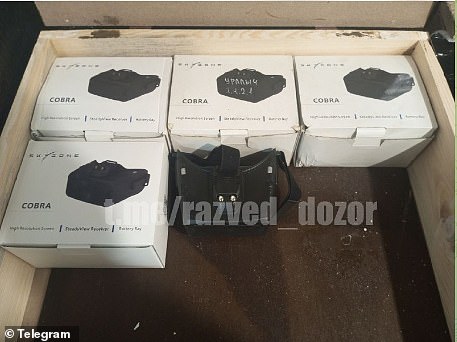A unit of Russian drone operators received an unpleasant surprise last week when a new batch of goggles used to control their unmanned aerial vehicles blew up in their faces.
The shipment, reportedly delivered to the Russian unit as part of a crowdfunded humanitarian aid package on February 7, contained several boxes of Chinese-made Skyzone Cobra X v4 goggles.
These goggles allow the operator to assume command of their UAV as if on board the craft, with the drone’s camera providing the pilot a first-person view (FPV) of the battlefield.
But when the goggles were turned on, the headsets exploded – causing serious injuries to the unfortunate drone pilots holding the devices.
The operation is reminiscent of Israel‘s sabotage of Hezbollah last year which saw thousands of the militant group’s members injured and dozens killed after their pagers were booby-trapped with a small amount of explosive.
Clips shared by pro-Kremlin military blogging channel ‘Razved Dozor’ showed investigators cracking open untouched headsets to discover plastic explosives buried beneath their casings.
Igor Potapov, a spokesperson for JSC NPP – a Russian company responsible for developing electronic warfare equipment – told the TASS news agency that the donation came from an individual named ‘Roman’ as part of an aid package.
‘I would like to especially note and convey to everyone that humanitarian aid always requires verification if it is provided by a new, unfamiliar person,’ Potapov said in a statement shared by Russia’s TASS news agency.
‘When some benefactor suddenly appears with a desire to help – this is, of course, wonderful – but such people always need to be verified.’

The shipment, reportedly delivered to the Russian unit as part of a crowdfunded humanitarian aid package on February 7, contained several boxes of Chinese-made Skyzone Cobra X v4 goggles

Clips shared by pro-Kremlin military blogging channel ‘Razved Dozor’ showed investigators cracking open untouched headsets to discover plastic explosives buried beneath their casings

Neither Razved Dozor nor the TASS news agency provided details of how many Russian drone operators were killed or injured in the sabotage attack

The shocking sabotage incident highlights the blurring of the lines between combatants and non-combatants in today’s modern warfare landscape amid the mass use of consumer drones on the frontlines (Ukrainian pilot is seen wearing a headset to operate an FPV drone)
Skyzone’s Cobra model has reportedly become a favourite of Russian drone operators for its high-quality imaging and robust signal control, and is routinely requested as part of crowdfunded aid shipments.
The shocking sabotage incident highlights the blurring of the lines between combatants and non-combatants in today’s modern warfare landscape amid the mass use of consumer drones on the frontlines.
With both Russian and Ukrainian army units relying on the goodwill of civilian benefactors providing them with warfighting equipment and humanitarian aid, the opportunity for such sabotage operations is greater than ever before.
Neither Razved Dozor nor the TASS news agency provided details of how many Russian drone operators were killed or injured in the sabotage attack.
But the military blogger reported that each headset is thought to have carried between 10-15 grams of plastic explosives.
If an operator was wearing the goggles when the explosives were activated, they certainly would have been killed.
No one has yet taken responsibility for the punishing operation, and the Armed Forces of Ukraine have not commented on the reports.
But it wouldn’t be the first time that Ukraine has used booby-trapped devices to take out Russians involved in the war.
In December, an attack orchestrated by Ukraine’s SBU security service – successfully eliminated Igor Kirillov, one of Vladimir Putin’s top army generals in charge of nuclear and biological forces, along with his assistant Ilya Polikarpov.
Shocking images showed their bloodied corpses lying on the snow-covered pavement outside a tower block in Moscow whose brickwork was left blackened following the small but powerful explosion from a device planted on an electric scooter parked outside.
Russian investigators revealed that the lethal charge was triggered remotely after they discovered a camera installed in a nearby rental car pointing at the building’s foyer from which Kirillov and his ill-fated assistant emerged.

Bodies are seen after a Ukrainian sabotage attack killed the commander of Russian armed forces’ chemical, biological and radiation defence troops, Igor Kirillov, and his assistant, in December 2024

It’s understood that the bomb was hidden inside an electric scooter when it detonated

Two bodies can be seen as bystanders watch emergency crews at the scene
Sources within the SBU confirmed to international press that the perfectly orchestrated hit was indeed the work of Kyiv’s operatives.
Dmitry Medvedev, deputy head of Russia’s Security Council chaired by President Vladimir Putin, described the attack as an attempt by Kyiv to distract public attention from its military failures and vowed that its ‘senior military-political leadership will face inevitable retribution.’
Kirillov, 54, had served as the Chief of the Russian Armed Forces’ Radiation, Chemical, and Biological Defence Troops since 2017.
He is believed to be the most senior military officer to be assassinated since Russia launched its full-scale invasion of Ukraine in February 2022.
The bombing – claimed by the Ukrainian security services – came a day after Kyiv had accused Kirillov of overseeing the widespread use of banned chemical weapons against its troops in the conflict zone.
Charging him in absentia with war crimes, the SBU said he was responsible for more than 4,800 documented cases of Russian troops using chemical munitions since the start of the full-scale war.
‘Such an inglorious end awaits all those who kill Ukrainians. Retribution for war crimes is inevitable,’ the SBU source said.







